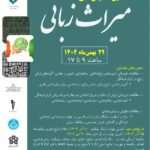Topographies of Rhetoric and Moral Reasoning in Sasanian and Post-Sasanian Zoroastrianism
- Bahram Roshan Zamir
- Events
- 2024/07/06

Professor Yuhan Sohrab-Dinshaw Vevaina (University of Oxford) delivered a four-part lecture series at the École Pratique des Hautes Études-PSL in Paris in May and June 2024. Invited by Professor Samra Azarnouche and Professor Philip Huyse, Yuhan Vevaina explored Zoroastrian moral philosophy and religious thought during and after the Sasanian Empire (224-651 CE).
Introduction:
After more than two centuries of the modern Zoroastrian studies, a comprehensive study of Zoroastrian theological discourse and interpretation methods from the Middle Persian (Pahlavi) texts is lacking. After publishing two books on Zoroastrian hermeneutics (Sūdgar Nask of Dēnkard IX, A Middle Persian book from the Nineth Century CE, https://www.harrassowitz-verlag.de/titel_7345.ahtml; https://www.harrassowitz-verlag.de/Zoroastrian_Hermeneutics_in_Late_Antiquity/titel_7346.ahtml). This Oxford scholar examined the “insider” (emic) perspectives to shed light on our understanding of moral reasoning, rhetoric, and identity formation and its metaphysical ground in a Zoroastrian discourse. Vevaina examined the transition of Zoroastrian literary forms from a mysterious archaic Avestan world to the scholastic knowledge production of the cosmopolitan late antiquity.
The Lectures:
1. The Past is a Foreign Country: Romanticisms and the Weight of ‘Tradition’
The first lecture examined how Pahlavi texts portray themselves as inheritors of ancient Avestan scriptures. It explored how Zoroastrian discourse developed a more reflective dimension unseen in earlier Avestan sources. It analyzed the strategies applied by Zoroastrian priests to overarch their realistic present to their idealized past.
2. Dispute and Difference: Disciplining Selves and Critiquing Others in a Multi-Cultural Empire
The second lecture delved into how Zoroastrians in the Sasanian Empire navigated a religiously diverse landscape. By bridging the Kērdir’s inscription from the third century to the Middle Persian Zoroastrian corpus, roughly six centuries later, Vevaina explored how Zoroastrians categorized and countered perceived threats from Christian, Jewish, Manichaean, and other religious communities. He further examined Zoroastrian polemics and apologetic writings as tools for maintaining clear religious boundaries.
Adding another layer of complexity, Vevaina explored the Denkard III passage on Xwedodah marriage. He argued that this text functioned as another tool for Zoroastrians to maintain social and religious distance from other groups. The Pahlavi authors, through analogies, aimed to demonstrate the perceived harm of religious and social mixing. Xwedodah marriage, according to this interpretation, served as a way to preserve social purity and prosperity within the Zoroastrian community.
3. Doubt and Decision-making: The Hermeneutics of ‘Choice’ in a Dualist World(view)
This lecture focused on the concept of “doubt” (gumān) in Middle Persian texts, a critical aspect of Zoroastrian moral reasoning. Examining this “insider” (emic) concept revealed how Zoroastrian theologians grappled with uncertainty and its impact on decision-making throughout history. Vevaina explored the processes and implications of these choices, shedding light on the core principles of Zoroastrian morality.
He highlighted how Zoroastrians, living in a dualistic world, self-consciously, made decisions and choices. The lecture traced the evolving understanding of doubt, from its archaic Avestan roots to its significance in the cosmopolitan late antique Iranian world. Doubt and decision-making were seen as crucial for Zoroastrians, potentially creating a moral ordeal for followers of the “good religion” (Weh-Dēn). Periods of doubt, for example, may have been associated with historical upheavals like Alexander’s supposed burning of the Avesta and destruction of dēn (tradition).
The wisdom of Zoroastrian priests in the late antique and early Islamic period (evident in texts like Wizīdagīhā ī Zādspram and the Dēnkard IV) lies in their recognition of the importance of discerning moral choices.
4- Profit and Loss / Benefit and Harm: Cosmographies and the Teleologies of Human History
This final lecture explored the Zoroastrian outlook on the future. Vevaina analyzed how Zoroastrian cosmography viewed the world not only as a battleground between good and evil, but also as predetermined, culminating in the ultimate victory of the first and the eradication of the latter. He drew examples from Pahlavi literature to demonstrate how this concept of dualistic predeterminism became ingrained in late antique Zoroastrianism.
The lecture, further, examined the role of “profit” (sūd) and “loss” (zyān) within this framework, highlighting their connection to ultimate moral goals. Building upon the work of scholars like Shaul Shaked, Philip Kreyenbroek, and Antonio Panaino, Vevaina viewed Pahlavi literature as a deliberate knowledge-production tool, employing myth and cosmography for didactic purposes. He analyzed how late antique Iranian thought emphasized the inevitability of an eschatological moment, both on a universal and individual level.
Vevaina also explored how some rituals were reinterpreted by the Zoroastrian exegetes using late antique idioms, such as the concept of an “investor.” Finally, Vevaina offered a critique of the work of American scholars Sam Harris and Danniel Dennett, arguing that they overlook the functionality and social value of religious discourse.
As announced by the seminar host, Samra Azarnouche, these lectures will be published soon as a book by the Bibliothèque des sciences religieuses of the École Pratique des Hautes Études thanks to Elahé Omidyar Mir-Djalali Institute of Iranian Studies.
A Gathering of Scholars:
The lectures attracted a distinguished audience of academics, including professors, specialists, and postgraduate students. The event fostered discussions among participants both in person and remotely. Scholars like Mattew Canepa, Alberto Cantera, Daniel Barbu, Muriel Debié, Frantz Grenet, Geoffrey Herman, Philip Huyse and Mihaela Timuş were attending the lectures.





